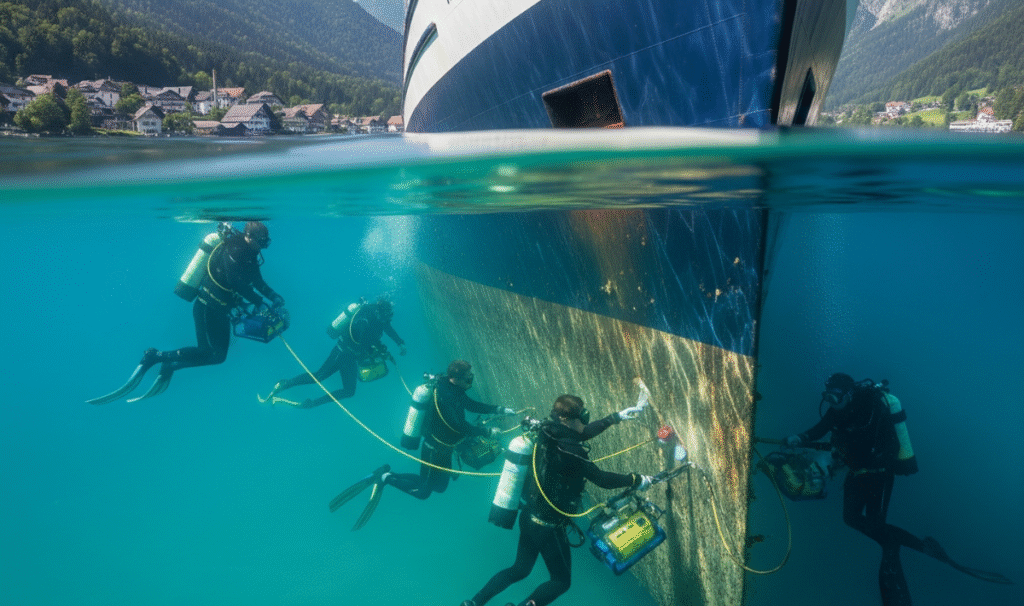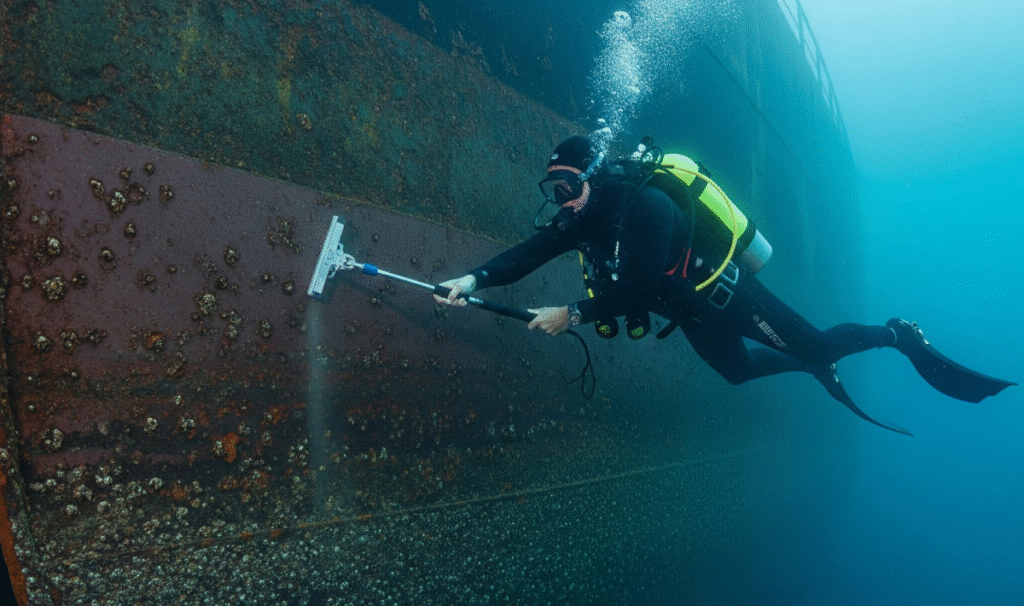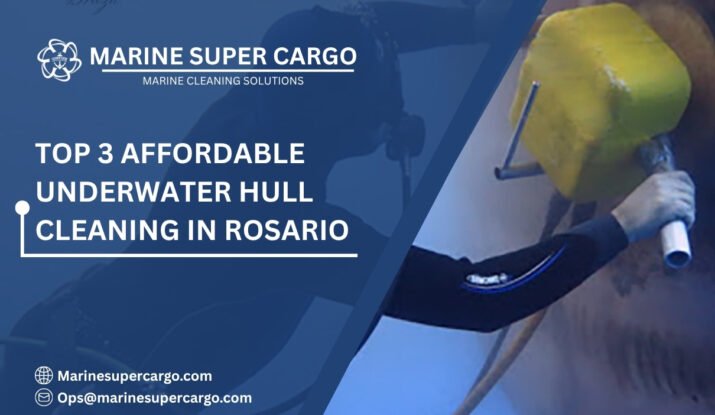Keeping your ship’s hull clean may not sound like the most glamorous part of vessel management, but it’s one of the smartest moves you can make when operating in competitive ports like Rosario. Imagine your ship as a marathon runner: if their shoes are caked with mud, performance suffers, energy drains faster, and the finish line feels much farther away. That’s exactly what happens when a vessel sails with a fouled hull.
In this article, we’re diving deep into the world of underwater hull cleaning in Rosario—why it matters, how it’s done, the challenges involved, and what the future holds. Whether you’re an owner, operator, or fleet manager, this guide provides clear, actionable insights to help you save costs, stay compliant, and operate efficiently.
Why Underwater Hull Cleaning in Rosario Matters More Than Ever
Your vessel’s hull is constantly exposed to the marine environment. Over time, algae, barnacles, and other biofouling organisms stick to it, forming a layer of resistance. Even what looks like a “slight discoloration” can reduce your vessel’s hydrodynamic efficiency significantly.
- A clean hull can cut fuel consumption by 5–20%.
- Less drag means lower greenhouse gas emissions.
- Biofouling, left unchecked, can lead to the transfer of invasive species, which IMO regulations strictly address.
In Rosario—one of Argentina’s busiest inland ports on the Paraná River—traffic density and sustainability pressures make hull cleaning a critical routine.
The Unique Port Environment of Rosario
Situated deep inland yet highly strategic, Rosario links Argentina’s agricultural heartland to global markets. Unlike open-sea ports, however, the Paraná River presents unique challenges:
- Shallow draft conditions demand that vessels maximize efficiency.
- Muddy waters encourage faster hull fouling.
- Frequent berthing and unberthing require ships to maintain peak maneuverability.
This makes underwater hull cleaning in Rosario not just an option, but almost a necessity for competitive operations.

How Underwater Hull Cleaning in Rosario Works
Think of hull cleaning as giving your vessel a much-needed spa treatment. The process, however, is highly technical.
Step-by-Step Overview
- Inspection — Divers or remotely operated vehicles (ROVs) assess hull condition.
- Preparation — Safety checks, permits, and environmental controls are put in place.
- Cleaning — Divers use mechanical brushes, scrapers, or hydraulic tools to remove fouling.
- Polishing — Advanced hull coatings are lightly polished for smoother flow.
- Post-Clean Survey — A final inspection confirms the hull’s restored condition.
Each step must align with guidelines from authorities like the IMCA (International Marine Contractors Association).
Compliance and Environmental Considerations
Compliance is often where the waters get murky. According to the IMO’s biofouling guidelines, ports and operators must minimize the environmental impact of hull cleaning. Random scrubbing without controls can release invasive species and toxic paint particles directly into the water.
- MARPOL Convention Annex V strictly regulates discharges.
- Some ports, including those in the Paraná River system, require pre-cleaning inspections and approval from local authorities.
- Best practices encourage capture-and-recovery systems to trap debris during cleaning.
For ship owners and managers, staying compliant during underwater hull cleaning in Rosario means more than avoiding fines—it positions you as a partner in sustainable shipping.
Cost-Saving Benefits You Shouldn’t Overlook
Fuel makes up 50–70% of a vessel’s operating costs. Even a marginal drag increase from biofouling significantly eats into your bottom line.
- A 5% efficiency loss could cost thousands of dollars per voyage.
- Regular hull cleaning extends coating life, delaying costly drydockings.
- Well-maintained hulls make ships more attractive to charterers and operators.
Think of hull cleaning as preventive maintenance—like changing the oil in your car—rather than a spare expense. When you invest in routine underwater hull cleaning in Rosario, the returns are immediate and measurable.
Read more on underwater hull cleaning in Argentina and the synergy between national policies and Durrës’ maritime initiatives.
The Shift Toward Eco-Friendly Practices
The shipping world is moving fast toward sustainability. Hull cleaning, once done with crude scraping tools, is now undergoing a green revolution.
- Robotic ROVs equipped with capture systems reduce diver risks.
- Non-toxic coatings make fouling removal easier and less harmful.
- Data logging systems track cleaning frequency and outcomes for better planning.
In Rosario’s freshwater environment, expect future adoption of smart ROVs and eco-focused technologies that align with global port initiatives like those from the IAPH (International Association of Ports and Harbors).
Key Challenges in Rosario
Despite the obvious benefits, carrying out underwater hull cleaning in Rosario comes with challenges:
- Visibility issues in muddy river water make diving work difficult.
- Strong currents near berths complicate positioning.
- Local regulations may vary, requiring constant updates on port approvals.
- Limited infrastructure compared to major seaports can affect service speed.
Ship managers must balance these hurdles with the cost and environmental pressures driving cleaning schedules.
Choosing the Right Hull Cleaning Strategy
Not all hulls, coatings, or voyages are the same. Instead of adopting a one-size-fits-all approach, consider these factors:
- Type of coating (self-polishing vs. foul-release).
- Voyage length (short inland trips need more frequent cleaning).
- Port turnaround times (combine cleaning with cargo operations where possible).
- Regulatory environment (always check Rosario’s port authority requirements).
The right strategy ensures compliance, cost savings, and smooth sailing between ports.
Best Practices for Ship Owners and Managers
If you’re planning underwater hull cleaning in Rosario, here are actionable best practices:
- Schedule cleaning regularly rather than waiting for visible fouling.
- Use certified contractors who follow IMCA and IMO guidelines.
- Consider advanced hull coatings that reduce fouling risks.
- Incorporate inspection reports into your broader Safety Management Systems (SMS).
These steps create a culture of proactive maintenance while aligning with international sustainability frameworks.

Future Outlook for Underwater Hull Cleaning in Rosario
Technology and regulation are steering hull cleaning into new waters. Expect:
- More robotics: Diverless cleaning with real-time data sharing.
- Regulatory tightening: Stricter enforcement under IMO’s biofouling rules.
- Port collaboration: Cleaner hulls are directly tied to reduced GHG emissions targets.
- Predictive analytics: AI-powered monitoring to trigger cleanings before fouling becomes costly.
Rosario’s position as a critical inland port will push innovation forward, making hull cleaning not just a routine but a strategic advantage.
Conclusion
Your ship’s performance begins below the waterline. Neglecting hull fouling is like running a marathon with weights strapped to your legs—inefficient, costly, and unsustainable. In Rosario, where river conditions, compliance requirements, and competitive pressures intersect, underwater hull cleaning in Rosario isn’t optional. It’s essential.
By embracing professional hull cleaning practices with trusted experts like CleanShip.co, staying compliant with IMO and MARPOL standards, and adopting innovative solutions, you’ll sail smoother, greener, and more cost-efficiently—ensuring long-term performance and sustainability for your fleet.
Read also: Underwater hull cleaning in Albania and how national policies align with Durrës’ local efforts.
FAQ:
Q1. How often should I schedule underwater hull cleaning in Rosario?
That depends on your vessel’s coating system and trading patterns, but inspections every 3–6 months are recommended in freshwater river conditions.
Q2. Is underwater hull cleaning in Rosario safe for the environment?
Yes, when done with approved methods that capture debris and minimize material discharge, aligning with IMO and MARPOL guidelines.
Q3. Can hull cleaning reduce my fuel costs significantly?
Absolutely. A clean hull can save 5–20% on fuel, depending on fouling severity.
Q4. Are robotic systems available for hull cleaning in Rosario?
They are emerging, though diver-based cleaning is more common today. Expect wider adoption of ROV solutions in the near future.
Q5. What happens if I skip hull cleaning for too long?
Performance loss, higher fuel costs, potential regulatory non-compliance, and expensive dry-docking sooner than planned.


